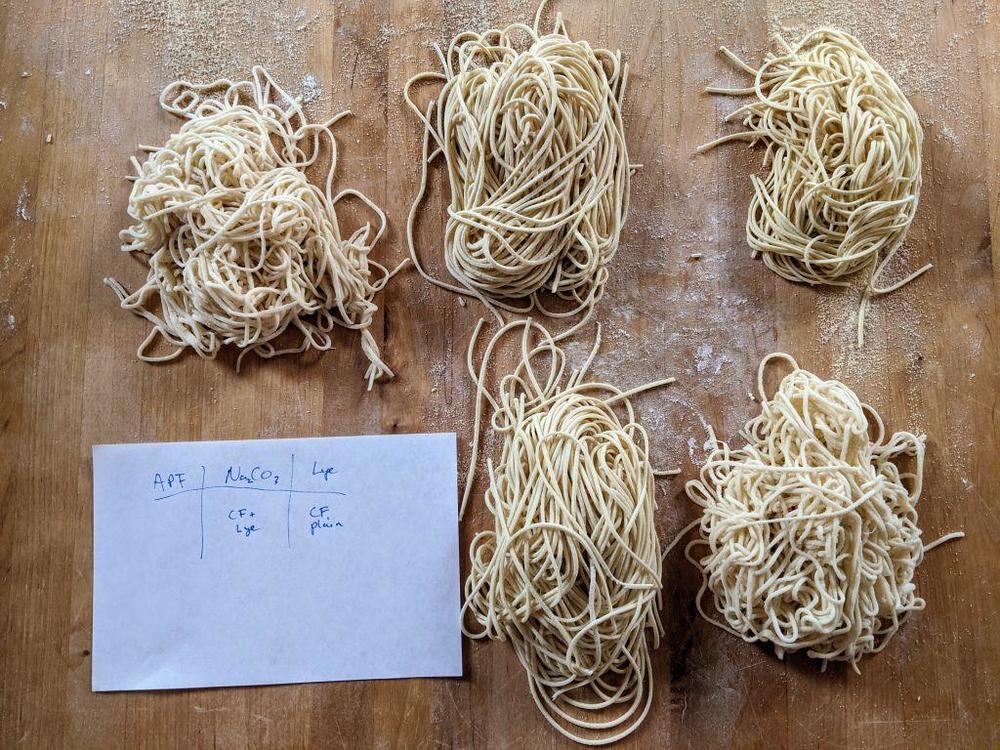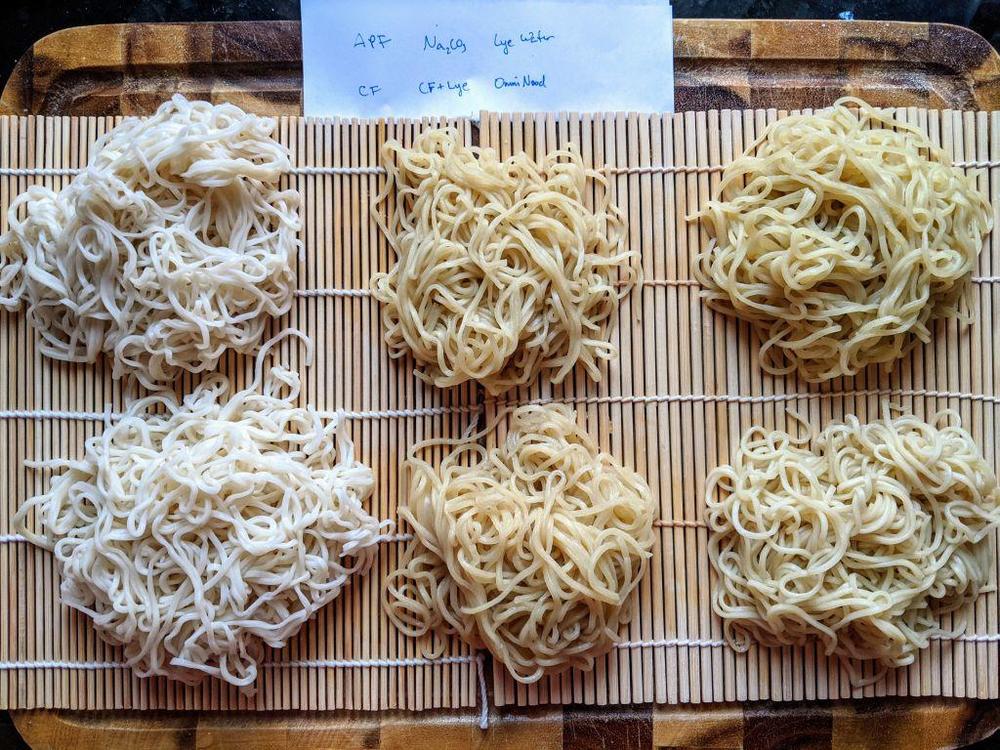Hi: Please follow along this silly rabbit hole ;D
@Kim Shook opened her noodle maker a few weeks ago, which inspired me to learn to make ravioli and tortellini - I have a ways to go, but having fun. I've made plenty of noodles before, especially 100% buckwheat, from fresh ground buckwheat, too! Tasty and fun.
Then @BKEats mentioned he or she was making alkaline noodles the other day. Kung Fu Panda movie flashed in my mind, and I really wanted noodle soup, but, this association of chicken broth made me want hainanese chicken with rice as well.
Researching alkaline noodles, there was a link in that post, which used sodium carbonate (baked baking soda). I tried that once with the buckwheat. Don't try it. It's disgusting 🤮, and I don't say this very often, I value almost all food and even enjoy eating bad food sometimes. There was a brief discussion about lye water, and I thought this was lye, but was wrong, it's a mix of potassium carbonate and either sodium carbonate or sodium bicarbonate (which is baking soda). Further research suggested no one knew the exact composition of lye water, and, it varies bran to brand. I found this gem, which tells us the composition of one brand! Here's the link, outside of EG: https://www.yumofchina.com/chinese-alkaline-water-noodles/
Today I made an experiment, because, well, I was curious. I made five noodles doughs, based on 100g flour and 40% hydration. I used Simple Truth Organic all purpose flour (which is a relatively "normal" flour in handling, nothing special) for three doughs: filtered water, 100% sodium carbonate, and my homemade lye water (see below). Then, after all the research, it's been my understanding the whole purpose of adding the alkaline water to the noodles was to strengthen weak flour.. so I pulled out the King Arthur Cake Flour buried deep inside the pantry, and made a dough each with plain and lye water. While I have borax in the garage, I did not feel comfortable eating it. I also have lye for making bagels, however, I did not want to experiment with this either.. baking at 400F is different from boiling at 212F. Again, note, lye water does not contain lye (aka sodium hydroxide!).
Process: 100g + 40g water + alkaline chemical if using; put in mini food processor, pulse until combined, kneed by hand for 10 minutes, wrap, and let relax for 1 hour. Cut in half (save half for thick noodle experiment later). Then flatten dough, using the marcato machine roll out a two times from 1-5 (fold in half after the first go), thin to 6, and run through the small cutter. Dust with semolina, rest, then cook in boiling water for 2.5 minutes, drain, rinse, dry. I tried to be very methodical in this, and as precise as possible.
Here are some stats you might find interesting:
1. pH of my filtered water is 6.53.
2. I dissolved 3.5g sodium carbonate in the 40g water, which yielded a pH of 9.82
3. pH of the lye water directly was 11.8
4. 3.5g lye water added to 38g water turns water pH to 11
5. Plain STO AP flour was super easy to kneed on its own
6. The cake flour was not a low-protein pastry flour, as I discovered later, it was harder to kneed than STO!
7. Adding either sodium carbonate or lye water to the dough made it very, very difficult to kneed
8. The cooked noodles with AP and Sodium Carbonate had a very strong eggy aroma and flavor, I didn't really care for it
9. Lye Water added a medium-level of eggy arroma and flavor, not really my thing!
10. I could not tell much of a difference between textures in the cooked product! Raw, the alkaline noodles were actually fun to handle, they didn't threaten to fuse and morph into each other like the plain water ones.
11. Alkaline noodles had a slight yellow color when raw. Sodium carbonate had a green hue cooked. In the photo of the cooked noodles, I may have accidentally swapped the top right two, should be lye water, then sodium carbonate. But I'm not really sure, could be camera processing playing tricks.
12. Left over dough scraps from all were mushed together, rolled out into more noods. These actually tasted pretty good.
13. Eggy flavor is more sulfur-like than actual egg. Not my thing.
14. The flavor goes away once sauce and other stuff are added to the noodles.
15. I think #6 was a little thin, I might prefer #5? Don't know.
16. Maybe I can tell difference in texture with thicker noodles. I may try that with the remaining doughs.
If that link above to the noodle making instructions goes bad, the measurements for unknown branded lye water were: 74.5g potassium carbonate and 3.5g sodium carbonate to 100g water (I know they say ml, but I've learned 1ml weighs roughly 1g). I used distilled water, with a neutral pH. I made sodium carbonate by roasting baking soda for a couple hours. When adding the potassium carbonate, be very careful.. it fizzed quite a bit and made the glass rather warm, borderline hot. I was not expecting a reaction! The common brand of lye water seems to use sodium bi-carbonate (baking soda) koon chun. As noted in many places kansui is the japanese version.
And now, please enjoy my noods.





